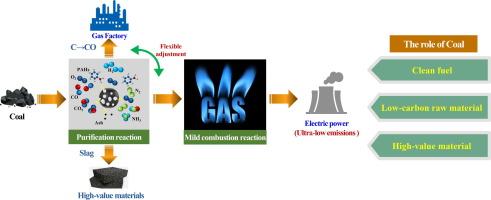A Novel Coal Purification-Combustion Technology: Purification Characteristics and Ultra-Low Nitrogen Combustion at Low Load
IF 11.6
1区 工程技术
Q1 ENGINEERING, MULTIDISCIPLINARY
引用次数: 0
Abstract
To meet the demand for clean and efficient coal utilization under low-load conditions and new power systems, an innovative coal purification-combustion technology is proposed in this study. The feasibility and fuel adaptability were verified using a 200 kW coal purification-combustion system. The high-temperature purification characteristics of three types of coal under a low load of 55 % and the nitrogen migration and transformation mechanism during the purification-combustion process were studied. The results show that the medium-temperature activation process mainly involves the release and reduction of volatile nitrogen to N2, with a nitrogen conversion rate of 43.8%–53.1%. During this process, coal powder activation is achieved, which significantly increases the specific surface area of the char, develops a pore structure, and increases the number of active sites, which are beneficial for high-temperature gasification reactions under low loads. During high-temperature purification, 62%–85% of the inorganic components were separated, achieving the separation of carbon and inorganic components. Coal powder is converted into high-temperature gaseous fuel, mainly composed of CO and H2, and the pore structure of char is further developed, which is conducive to stable combustion under low loads. The high-temperature purification process mainly involves the release and reduction of char nitrogen to N2, with a nitrogen conversion rate of 93.6%–96.6%. The fuel, mainly composed of high-temperature CO and H2, achieved a moderate or intense low-oxygen dilution (MILD) combustion process. In the reduction zone of the combustion furnace, NH3 was completely converted to N2 and char nitrogen was gradually released and reduced to N2, with a nitrogen conversion rate of 99.6% in the reduction zone. The oxidation zone involves the burnout of char, which mainly releases char nitrogen and oxidizes it to NOx. Ultimately, only 0.2%–0.9% of the coal nitrogen is converted to NOx. The minimum original NOx emissions of the three types of coal at low loads were 28 mg·Nm−3 (@6% O2), and the combustion efficiency exceeded 99.6%.

一种新型煤净化燃烧技术:净化特性及低负荷超低氮燃烧
为满足低负荷条件下和新型电力系统对煤炭清洁高效利用的需求,本研究提出了一种创新的煤炭净化燃烧技术。通过一个200kw的煤净化燃烧系统验证了该方法的可行性和燃料适应性。研究了三种煤在55%低负荷下的高温净化特性及净化燃烧过程中氮的迁移转化机理。结果表明:中温活化过程主要是挥发性氮释放还原为N2,氮气转化率为43.8% ~ 53.1%;在此过程中,实现了煤粉活化,显著增加了焦炭的比表面积,形成了孔隙结构,增加了活性位点的数量,有利于低负荷下的高温气化反应。在高温净化过程中,分离了62%-85%的无机组分,实现了碳与无机组分的分离。煤粉转化为高温气态燃料,主要由CO和H2组成,煤焦孔隙结构进一步发育,有利于低负荷下稳定燃烧。高温净化过程主要是将焦氮释放还原为N2,氮气转化率为93.6% ~ 96.6%。燃料主要由高温CO和H2组成,实现了中等或强烈的低氧稀释(MILD)燃烧过程。在燃烧炉还原区,NH3完全转化为N2,炭氮逐渐释放还原为N2,还原区氮气转化率达99.6%。氧化区主要是炭的燃尽,主要是炭氮的释放,并将其氧化为NOx。最终,只有0.2%-0.9%的煤氮转化为氮氧化物。三种煤在低负荷时的最小NOx原始排放量为28 mg·Nm−3 (@6% O2),燃烧效率均超过99.6%。
本文章由计算机程序翻译,如有差异,请以英文原文为准。
求助全文
约1分钟内获得全文
求助全文
来源期刊

Engineering
Environmental Science-Environmental Engineering
自引率
1.60%
发文量
335
审稿时长
35 days
期刊介绍:
Engineering, an international open-access journal initiated by the Chinese Academy of Engineering (CAE) in 2015, serves as a distinguished platform for disseminating cutting-edge advancements in engineering R&D, sharing major research outputs, and highlighting key achievements worldwide. The journal's objectives encompass reporting progress in engineering science, fostering discussions on hot topics, addressing areas of interest, challenges, and prospects in engineering development, while considering human and environmental well-being and ethics in engineering. It aims to inspire breakthroughs and innovations with profound economic and social significance, propelling them to advanced international standards and transforming them into a new productive force. Ultimately, this endeavor seeks to bring about positive changes globally, benefit humanity, and shape a new future.
 求助内容:
求助内容: 应助结果提醒方式:
应助结果提醒方式:


